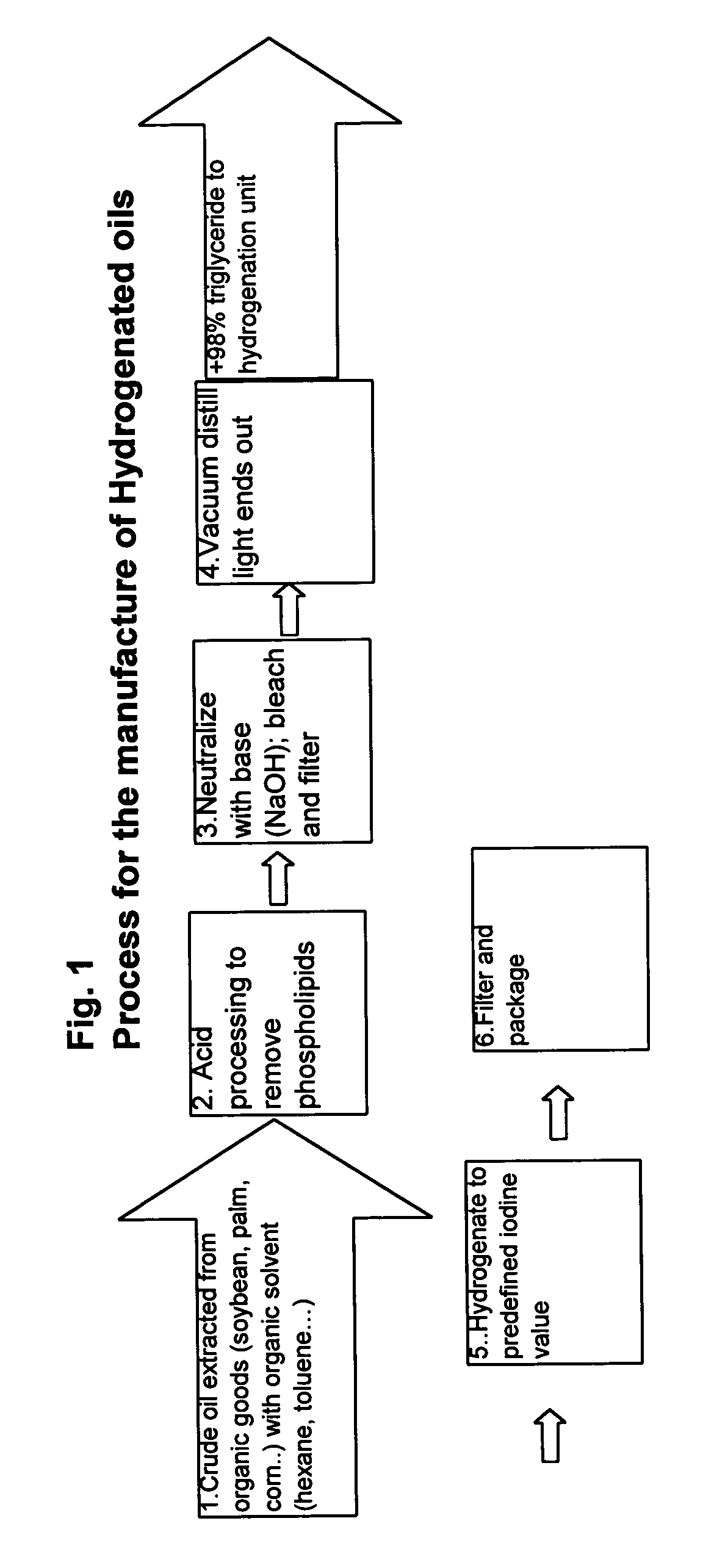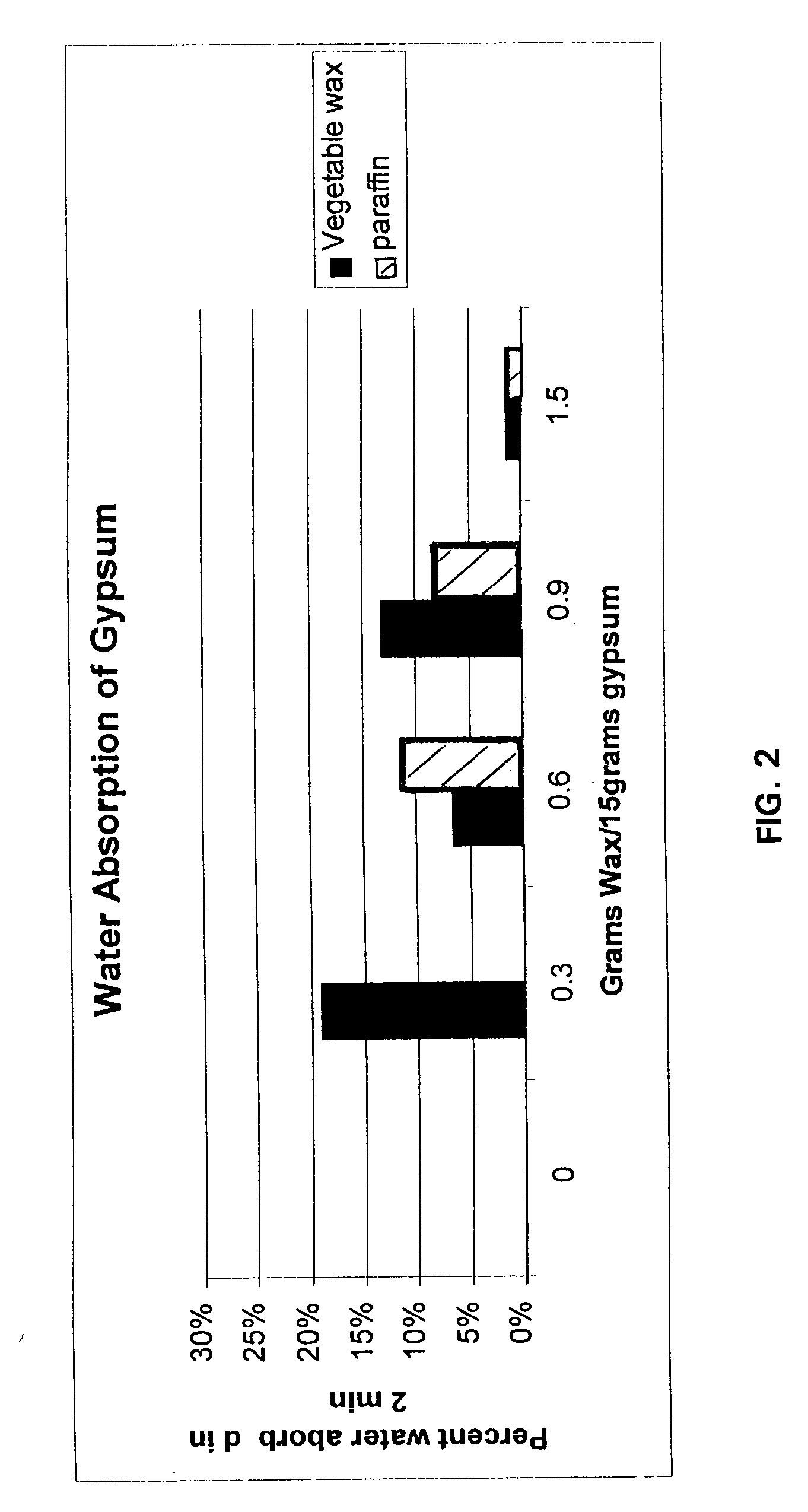Additive to render gypsum board moisture resistant
a technology of gypsum board and additives, which is applied in the field of additives to improve the water resistance of gypsum-based structural panels, can solve the problems of black stains appearing on the finished product, difficulty in re-emulsifying separated emulsions, and rapid absorption of water. the effect of water and moisture resistan
- Summary
- Abstract
- Description
- Claims
- Application Information
AI Technical Summary
Benefits of technology
Problems solved by technology
Method used
Image
Examples
example 1
Effect of Water Based Emulsion of Triglyceride Wax on the Water Resistance of Gypsum
[0096] For the purpose of illustrating the invention, standard grade gypsum samples (non water resistant) were taken from an 8 ft by 4 ft standard ½ in. thick gypsum board purchased at a commercial building supply store. The manufacturer of the board was United States Gypsum Corp, Chicago, Ill. Samples were prepared by cutting 6 in. by 6 in. squares of gypsum from the center portion of the board and scraping the paper off each side of the board. Additionally, approximately 1 / 16 in. of gypsum directly adjacent to the paper facing was scraped off. The resulting gypsum was pulverized with a mallet and screened through a 12-mesh screen. The gypsum powder was placed in an open metal container and placed in a preheated oven at 530 degrees F. for a period of one hour. The resulting anhydride gypsum was labeled ‘calcium sulfate hemihydrate’ used to prepare samples for evaluation.
[0097] An emulsion was prep...
example 2
Effect of Powdered Vegetable Wax on Moisture Resistance of Gypsum
[0102] A sample of Marcus Nat Wax 155 (Soy wax) was placed into a 400 ml Sorvallâ (Norwalk, Conn.) stainless steel chamber and ground. The ground wax was screened through a 75-mesh screen.
[0103] A sample of powdered paraffin wax (supplied by Moore and Munger Corp.) with a melting point of 139 degrees F. was prepared using a razor and shaving thin films off the blocks of wax. The shavings were frozen and then pulverized to flakes averaging 1-3 mm in diameter.
[0104] Calcined gypsum was weighed in a 50 ml glass flask and dry mixed with the indicated quantities of dry wax (see Table 2). Water was then added and mixed with a glass rod until a consistent smooth mix was obtained. The mixture was placed in round PVC cylinders with an inner diameter of 1½ in. and ½ in. height that had been placed atop a glass plate. The PVC cylinders were sprayed with a light coat of silicone release (Nappa) prior to placing the gypsum slurr...
example 3
Effects of Vegetable Wax Addition to Gypsum: Strength Testing
[0109] To test the effect of adding vegetable derived wax to gypsum, gypsum samples were prepared using the formulations indicated in Table 3 (below). The gypsum slurries were then placed in an extruded aluminum channel to create 8 mm×8 mm sticks of samples that were then placed in a locking vice, thus creating a cantilever bar. Force was applied to the cantilevered bar approximately 5 mm in front of the cantilever point until the specimen failed. The amount of force, as measured in grams, was recorded at the point of failure.
[0110] Table 3 indicates that addition of vegetable-derived wax to gypsum does not have an adverse effect on the strength of gypsum.
TABLE 3Cantilevered Strength TestingPowderedPowderedWaterForce toSampleCalcinedNat 155139F ParaffinAdded toBreakNoGypsumWaxWaxPowderSample*#17.5 gm0.75 gm04.0 gm670 gm#27.5 gm004.0 gm540 gm
*Sample consists of 8 mm square molded gypsum × 1 in. length held in cantilever...
PUM
| Property | Measurement | Unit |
|---|---|---|
| wt. % | aaaaa | aaaaa |
| weight percent | aaaaa | aaaaa |
| weight ratio | aaaaa | aaaaa |
Abstract
Description
Claims
Application Information
 Login to View More
Login to View More - R&D
- Intellectual Property
- Life Sciences
- Materials
- Tech Scout
- Unparalleled Data Quality
- Higher Quality Content
- 60% Fewer Hallucinations
Browse by: Latest US Patents, China's latest patents, Technical Efficacy Thesaurus, Application Domain, Technology Topic, Popular Technical Reports.
© 2025 PatSnap. All rights reserved.Legal|Privacy policy|Modern Slavery Act Transparency Statement|Sitemap|About US| Contact US: help@patsnap.com


